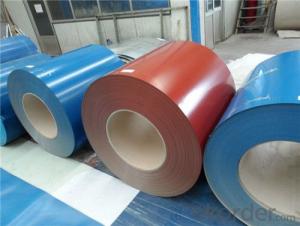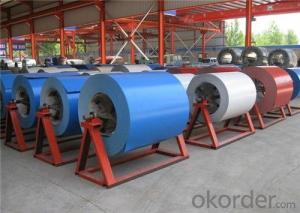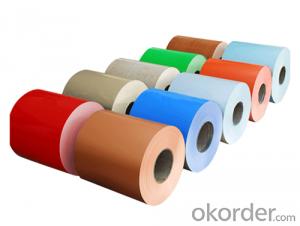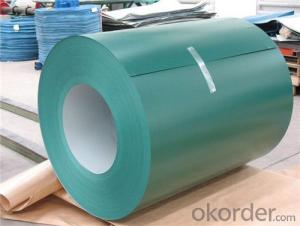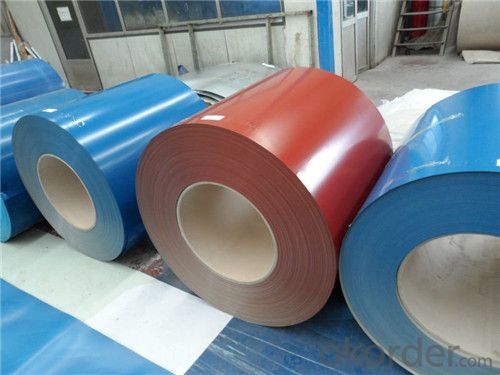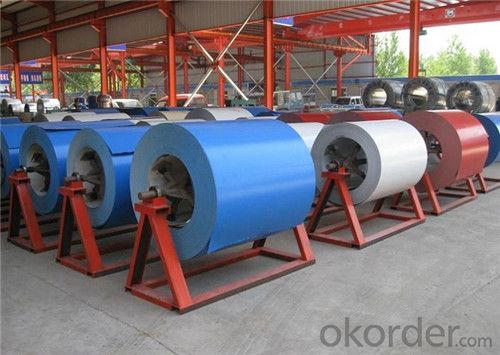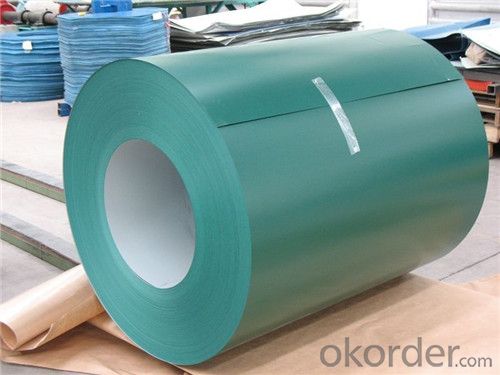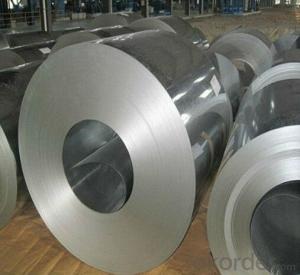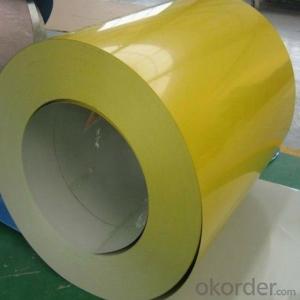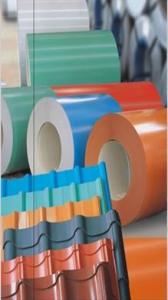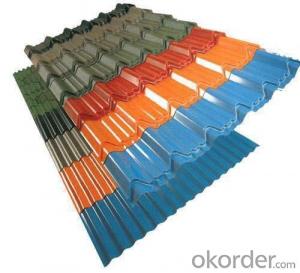color Coated gAlvanized Cold rolled Steel coil
- Loading Port:
- Tianjin
- Payment Terms:
- TT OR LC
- Min Order Qty:
- 25 m.t.
- Supply Capability:
- 300 m.t./month
OKorder Service Pledge
OKorder Financial Service
You Might Also Like
Product Description
Specifications
Color Coated Steel Coil/PPGI/Prepainted Galvanized Steel Coils
Standard: JIS,ASTM,GB,DIN.
Technique: Hot dipped Cold-rolled PPGI
Nominal Thickness: 0.13mm-1.5mm
Nomina Width: 600mm-1250mm
Coil Weight: 3MT-8MT.
Zinc Coating: 40g-275g
Surface Finish: normal coated, embossed patterns, printed patterns
Color Coated Steel Coil/PPGI/Prepainted Galvanized Steel Coils :
1.Best price,high quality
2.12 years history
3.Special factory
3.ISO,SGS,BV
Feature OF ppgi steel coil /ppgi sheet :
1. The sheets excellent with weather resistance and color stability , long life span up to 25--40 years and 10 year free from color fading .
2. Decorative ability, bring the roof fantastic wavy look and multi-dimensional effect.
3. Good load-carrying ability and anti-impact resistance , the test show no crack happened after 1 kg steel ball drop from 3 meters on sheet.
4. Excellent corrosion resistance , free from corrosion of varoius chemical substances such as acid ,alkali and salt .
5. Heat insulation , the coefficient of heat conductivity is 0.325W/M.K, which is 1/310 of clay tile and 1/5 of cement tile , it can reduce cooling costs in your home or office .
6. Good fireproofing performance , according to GB8624-2006 fireproofing ≥class B.
7. excellent waterproof performance , no water absorb and seep.
8. Green and environment friendly , dont contain asbestos and any redioactive element , can be recycled.
9. Easy to install , 960mm effective width and customized length ensure fast installation .
10. Self-cleaning performance , it dont absorb dust and very easy clean by rain.
| Prepainted Galvanized Steel Sheet Grade | Chemical Composition % | Mechanic Property | ||||||
| C | Si | Mn | S | P | T.S | Y.S | E.L | |
| x103 | x103 | x102 | x103 | x103 | Mpa | Mpa | % | |
| JIS G3302 SGCC | 12 | 30 | 41 | 31 | 21 | 480 | 300 | 13 |
| JIS G3302 SGCH | 12 | 10 | 21 | 18 | 8 | 680 | 650 | |
| ASTM A653 CS.B | 20 | 30 | 60 | 35 | 30 | 386 | 205~380 | 20 |
| EN 10346 DX51D+Z | 29 | 21 | 18 | 1.8 | 11 | 355 | 245 | 38 |
| G550 | 20 | 6 | 73 | 5 | 17 | 715 | 654 | 8 |
- Q: How do steel coils contribute to acoustic performance in buildings?
- Steel coils can contribute to acoustic performance in buildings by providing a solid structure that reduces vibrations and sound transmission. The use of steel coils in construction helps dampen noise by absorbing and dissipating sound waves, resulting in a quieter and more comfortable indoor environment.
- Q: PLEASE PLEASE PLEASE!!!!!!!! HELP MEEEEEEEE!!!!!!! I need to know how can i prevent steel from rusting when it is exposed to water or salt water or vinegar. PLEASE TELL ME A LOT OF WAYS THAT I COULD PREVENT IT!!!!!!!!!!!!!!!!!!!!!!!!!!!!!!!!!!!!!!
- rust is oxidation . remove contact with O2 , it wont rust . you can place it in a oxygen free atmosphere , you could plate it with zinc or chrome , you can use a lead based paint .
- Q: What are the challenges in coil leveling for coated steel?
- Coil leveling for coated steel presents several challenges due to the additional layer of coating. Firstly, the coating can be sensitive to pressure and friction, making it prone to damage during the leveling process. Maintaining the integrity of the coating while achieving the desired flatness of the steel is a delicate balance. Additionally, the thickness of the coating can vary across the coil, leading to uneven leveling results. The choice of leveling equipment and parameters must be carefully determined to minimize coating damage and ensure consistent flatness throughout the coil. Moreover, the presence of coating can impact the accuracy of leveling measurements, as it may interfere with the sensors or affect the readings. These challenges require careful attention and expertise to successfully level coated steel coils while preserving the quality of the coating.
- Q: Steel is no doubt a better constructin material but it is only in practice in developed country.i would like that we should high lights the benifits and negatives of steel to make the steel more clear as a construction material.Hope some expert to address this topicMD
- Steel Structure considered as the most efficient and fast in completion of any project, specially the high rise buildings, also the logistics during construction is less complicated than the normal methods, Steel Structure has so many advantages vs the disadvantages, and highly recommended for commercial buildings
- Q: pros and cons of stainless steel and carbon steel swords
- Carbon is what samurais added to their swords to make them super strong. The iron ore was cooked in coal for days; the coal adds the carbon. Too much carbon or too little carbon is a bad thing so it was a very important process. I'd have to go with a sword with carbon.
- Q: What are the different steel coil finishes available?
- Some common steel coil finishes include hot rolled, cold rolled, galvanized, and coated finishes.
- Q: steel structure
- Disadvantages Of Steel
- Q: What are the main factors that affect the paint adhesion on steel coils?
- The main factors that affect paint adhesion on steel coils are surface cleanliness, surface roughness, presence of contaminants, proper surface preparation, and the type of paint or coating being used.
- Q: I have a knife with AUS8 Stainless Steel. No idea what that means. I want to know some of the best stainless steels for knifes and all you can tell me about stainless steel would be great. I was browsing google and looking at grades and had no idea what all the numbers meant. Thanks!
- I do engraving on knife blades (actually all kinds of metal but occasionally knife blades). Every company's blades are a little different. I get the idea that different companies have different compounds. All the materials are some compromise between hardness, toughness, corrosion resistance, machineability and other considerations. Stainless is generally not as good as a high-carbon steel, but high-carbon steel rusts and turns black. Stainless is much easier to keep clean.
- Q: I am about to do a welding project and we are instructed to only use mild steel. I want to use found objects like coins, spoons, bottle caps, screws, and other small fasteners. Are these mild steel? What other objects can I use that are mild steel?
- Mild steel is what your friends get when they see your mom's cleavage.
Send your message to us
color Coated gAlvanized Cold rolled Steel coil
- Loading Port:
- Tianjin
- Payment Terms:
- TT OR LC
- Min Order Qty:
- 25 m.t.
- Supply Capability:
- 300 m.t./month
OKorder Service Pledge
OKorder Financial Service
Similar products
Hot products
Hot Searches
Related keywords
